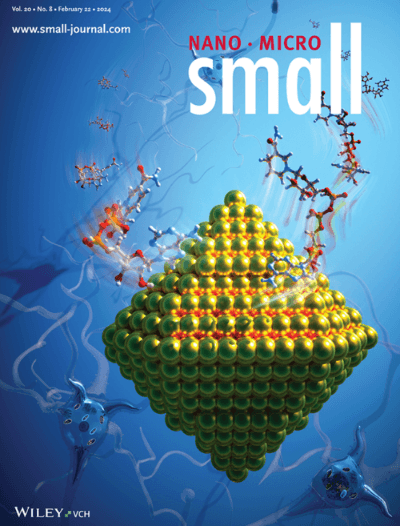
Hui Wang group recently published a paper in Small, which was featured on the inside cover of the February 22 issue of the journal.. This work involved collaborations with Clene Nanomedicine, Inc. (Salt Lake City, Utah), the University of Bordeaux and Neuro-Sys in France. It has been well-received by the nanobiotechnology community and reported by multiple news media as well as the college’s news site. The first author on this paper is Zixin Wang, a former Ph.D. student in Professor Wang group. She is currently a postdoc at Los Alamos National Lab.
Wang, Z.X.; Henriques, A.; Rouvière, L.; Callizot, N.; Tan, L.; Hotchkin, M.T.; Rossignol, R.; Mortenson, M.G.; Dorfman, A.R.; Ho, K.S.*; Wang, H.*, A Mechanism Underpinning the Bioenergetic Metabolism-Regulating Function of Gold Nanocatalysts. Small 2024, 20, 2304082. https://onlinelibrary.wiley.com/doi/10.1002/smll.202304082
This work provides mechanistic insights into the energy metabolism-regulating function of colloidal Au nanocrystals, referred to as CNM-Au8, that are synthesized electrochemically in the absence of surface-capping organic ligands. When neurons are subjected to excitotoxic stressors or toxic peptides, treatment of neurons with CNM-Au8 results in dose-dependent neuronal survival and neurite network preservation across multiple neuronal subtypes. CNM-Au8 efficiently catalyzes the conversion of an energetic cofactor, nicotinamide adenine dinucleotide hydride (NADH), into its oxidized counterpart (NAD+), which promotes bioenergy production by regulating the intracellular level of adenosine triphosphate.
Detailed kinetic measurements reveal that CNM-Au8-catalyzed NADH oxidation obeys Michaelis–Menten kinetics and exhibits pH-dependent kinetic profiles. Photoexcited charge carriers and photothermal effect, which result from optical excitations and decay of the plasmonic electron oscillations or the interband electronic transitions in CNM-Au8, are further harnessed as unique leverages to modulate reaction kinetics. As exemplified by this work, Au nanocrystals with deliberately tailored structures and surfactant-free clean surfaces hold great promise for developing next-generation therapeutic agents for neurodegenerative diseases.